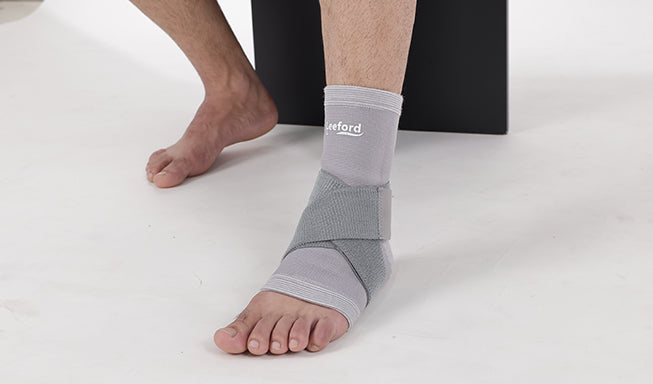Have you ever wondered if you are using this ankle splint correctly? Or questioned, "How do I use an ankle splint correctly for recovery?" Most of us do not recognize how crucial it is to wear an ankle splint correctly for effective healing. Whether you have a severe or minor ankle injury, always ensure that you are following the best practices for ankle splint use. Mistakes to avoid when using an ankle splint include choosing the wrong fit, cleaning it with chemical detergent, wearing it before it's completely dry, removing it too often, or removing it without a doctor’s guidance. Consider Leeford Ortho ankle support gear that includes ankle support, an ankle binder, and an ankle binder with a splint.
Let’s explore in detail the do’s and don’ts when wearing an ankle splint.
How Long Should I Wear My Ankle Splint Each Day?
It depends on how severe your injury is, your daily tasks, and the stage of recovery to determine how long you can wear an ankle splint. It is wise to consult a healthcare expert for a proper examination. However, a general guideline recommends wearing it for extended periods during the day, especially in the early injury stage. As you heal, wear it only during repetitive motion activities, such as walking or standing. This helps to minimize stress and strain on the ankle joints.
Early Recovery Stage
Know when to wear: Wear the splint during the day, especially when performing tasks or walking. This provides you a safe support and stability to prevent chances of further injury.
Remove at night: Take off the ankle splint when sleeping to give your skin a chance to breathe and to prevent irritation or blisters.
Elevated Support: Keep your foot raised on soft surfaces like a pillow or cushion. This helps prevent applying extra weight and strain to the injured ankle, especially in the first 1-2 weeks, when the ankle is vulnerable.
Later Recovery Phase
Gradual reduction in pain and discomfort associated with the problem: You can take breaks from wearing the ankle splint for long periods. Such as during the day, when you experience a gradual increase in pain and swelling.
- Daily activity wear: Wear the ankle splint while performing activities, even if they are low-impact tasks. This helps to prevent sudden accidents and the risk of injury recurrence. It helps to balance applied stress on the ankle, whether you’re walking on a hard surface or doing household chores
- Low-risk tasks: Your doctor might advise you to skip wearing the splint on other days. This is meant to promote natural healing and to prevent ankle dependency on the splint, as it might lead to muscle weakness and slower recovery.
Always remember to follow your doctor's advice, as it helps you create a long-term plan for when to wear the ankle splint, which might be for specific activities only.
Can I Walk with an Ankle Splint?
You can walk in an ankle splint, but it may be uncomfortable right after a serious injury. Seek your doctor’s advice, and follow the given instructions to promote safe and effective recovery. Consider a Leeford Ortho ankle support gear that enables supported and controlled movement. Controlling movement protects your ankle from sudden accidents like bumping into a stone or twisting when you miss a step. It basically restricts unnecessary movement; however, you can walk around or perform your daily tasks while wearing it.
Here are tips for walking safely:
- Always wear shoes with supportive soles or with a splint to prevent straining and irritating your ankle ligaments.
- Incorporate crutches (only if suggested by your doctor)
- Avoid prolonged periods of standing or walking, especially on harsh or uneven surfaces.
- Adjust the ankle splint for a snug fit; make sure it's not too loose or too tight.
What Happens If I Wear My Ankle Splint Too Tight?
Wearing an ankle splint too tightly can trigger various complications or discomfort, like nerve damage, swelling, and slower recovery.
You can notice these symptoms to determine if your ankle splint is too tight:
- Loss of sensation when walking: This sensation could be a sign that the splint is pressing on your ankle nerves.
- Lingering pain even when resting: It could be a sign that your splint is too tight if pain increases when you rest.
- Bluish/pale skin: A tight ankle splint often reduces or cuts off blood from flowing in the injured ankle region, leading to bluish or pale skin.
- Swolleness: Continuous swelling on the ankle region that doesn't improve might mean you're wearing the splint too tightly.
- Coldness: A cold sensation that occurs frequently could be a sign that you’re wearing the splint too tightly.
How Do I Clean My Ankle Splint?
It's crucial to consult your healthcare provider before attempting to clean the ankle splint. The results of how you clean the ankle splint often depend on the type of your injury and how severe it is. Here are ankle splint care tips:
- Regular or light cleaning: Apply a chemical-free soap on a damp cloth. Gently wipe the outside of the splint. You can use a mild detergent on the cloth and wipe the outside and inside of the splint to prevent odor formation.
- Complete cleaning: Check if there are any detachable parts of the splint before soaking the splint in chemical-free detergent. Wash it by the hand method and rinse with water to remove the detergent residue. Make sure it's completely dry before wearing it again.
Can I Exercise While Wearing an Ankle Splint?
Consult your doctor before doing any exercises. The type of your injury, its severity, and your daily routine determine the result. However, you can engage in exercises like ankle circles or resistance bands while wearing an ankle splint. A splint is a medical device for supporting an injured ankle, and it is not intended for use during athletic activities without medical guidance. Engage in low-impact or non-weight-bearing movements to prevent straining and stressing the injured ankle.
Wrapping Up
Always remember that effective recovery is achieved not just by wearing an ankle support gear but by following the ankle splint wearing guide and the best practices for ankle splint use. Consider using Leeford Ortho Ankle Support, Ankle Binder, or Ankle Binder with Splint. These orthopedic support devices help mobilize and restore ankle strength. It’s crucial to know that an ankle support enables movement and only minimizes risky or unnecessary movements.
One of its primary goals is to prevent further injury or slower recovery. Avoid engaging in high-impact movements when wearing the splint or wearing it too tightly. Consult your healthcare provider for guidance. This helps to determine whether you can remove the splint when cleaning it or clean it while wearing it. It might just be the simple yet powerful solution your ankle needs.





